
Mastering Clear Sound Techniques for Eliminating Audio Distortion in Videos

Mastering Clear Sound: Techniques for Eliminating Audio Distortion in Videos
Create High-Quality Video - Wondershare Filmora
An easy and powerful YouTube video editor
Numerous video and audio effects to choose from
Detailed tutorials are provided by the official channel
Whether you are in the business of shooting or editing, noisy or distorted footage is among the most frustrating roadblocks you’ll ever encounter in your workflow. The magic of filmmaking lies after the scenes in post-production. You can remove distortion from audio using various methods.
In this article
01 What Is Distortion in Audio?
02 The Difference Between Noise and Distortion
03 How to Remove Distortion From Audio for Your Video
What Is Distortion in Audio?
You have probably heard the term distortion and would like to know what it is. Distortion is a common term in music production.
Although the term is simple, there is more than meets the eye. Distortion is defined as the change or deformation of an audio waveform that results in the production of an audio output that is different from the input. Distortion can occur at a single point or multiple points in a specific signal chain.
While there are many types of audio distortion, the most common one is clipping. It occurs when an audio signal is amplified beyond the maximum allowed unit in both analog and digital systems.
A signal is distorted when an output does not record the same signal as the input. The issue can occur due to amplifier clipping, faulty equipment, overloading of a sound source, production of hot signals, and pushing speakers beyond their limit.
In the past, people perceived distortion as a bad thing. Today, however, some kinds of distortions are considered beneficial because of their positive effect on the sound. Sound engineers apply plugins, outboard gear, and other techniques to add pleasing distortions to audios. The distortions work by adding unique elements to audios, thus improving sounds in many instances.
The Difference Between Noise and Distortion
Noise and distortion can sound very similar and hard to tell apart. However, the two are different phenomena with unique characteristics. Noise is an undesired disturbance that sounds white or pink and creates an even-tempered sound wave. On the other hand, distortion is the alteration of a waveform, where some parts are amplified while others are attenuated, leading to an uneven distribution of energy among frequencies. Let’s look at the differences between noise and distortion.
1. Where It Appears in a Signal
Noise appears randomly throughout the signal, while distortion seems at the same frequency. One example of noise is an audio hiss that can be heard when no other sounds are present. An example of distortion is a sine wave with a flat top and bottom combined with different amplitudes.
2. How It Affects Signals
Noise is random and can appear when signals are quiet. Distortion is affected by the input signal and can be altered by adding or removing signal frequencies.
How It’s Measured
You can measure distortion by using an oscilloscope to display the input signal’s waveform over time. The oscilloscope measures energy distribution among different frequencies, while you can measure noise with a spectrum analyzer by displaying an audio signal’s magnitude and frequency content over time.
Despite their differences, noise and distortion are both unwanted sounds. When they are present in a signal, they can degrade its quality. For this reason, it is essential to understand the differences between them to assess signs and produce better results accurately.
How to Remove Distortion From Audio for Your Video
You can use several different methods to remove audio distortion in your video. They include:
Method 1: Use an Online Audio Distortion Tool
You can use an online distortion tool to fix this problem. One of the popular tools for removing distortion from audio is Audacity. Available for Linux, macOS, Windows, and other Unix-like operating systems, Audacity is a FOSS (free and open-source digital audio editor software). It is also a recording application software, and you can use the program for varying tasks, including conversing audio files, removing audio distortion, adding effects, and mixing audio clips.
Keeping this in mind, let’s look at how to remove distortion from audio using Audacity.
- The first step is opening the file. To do this, drag and drop the audio file into Audacity.
- Next, you need to select the distorted area before clicking on Effect. Once you have done this, click on the Noise Reduction option.

- Doing this will open the Noise reduction window.
- Go to the Noise Profile and click on it; this will allow Audacity to know what it should filter out.

- Now, select the whole audio before reopening the Noise Reduction Window. Set the values as you see necessary.
- Check the audio by clicking Preview. If you are satisfied with the results, click OK.
- Be sure to apply the filter again if your audio is still distorted. Avoid doing it excessively, as the audio could be degraded. In turn, this can lead to the voice sounding robotic and tinny.
Method 2: Software Solutions - Adobe Audition
You can remove distortion from audio using specialized audio editing software. One of the professional audio tools that you can use to fix audio distortion is Adobe Audition; this software allows you to carve out any unwanted sound for impressive results.
These steps below will allow you to remove distortion from audio with Adobe Audition.
- Double click on the track to access the Waveform.
- Go to Window, and then select the Amplitude Statistics option.
- A new window will open. Now, hit the Scan button in the left corner. The software will then scan the audio.

- Check the section written Possibly Clipped Samples.

- Head over to Effects>Diagnostics> DeClipper.

- In the Preset section, select the Restore Heavily Clipped option.

- Next, hit the Settings button, and adjust the Tolerance.

- Hit the Scan button again, and you’ll see all the problems in your audio.
- Click Repair all to fix your distorted audio.

- Alternatively, you could head to Effects Rack and click on Filter and EQ, then FFT Filter.

- Put the Preset option to Default settings. Take out a few of the frequencies where your audio is distorted.

Method 3: Video Editing Tools like VSDC
When it comes to removing distortion from audio, you can use video editing tools to fix this problem. VSDC is one of the non-linear editing applications that people use to remove audio distortion.
Follow the steps below to learn how to remove distortion from audio using VSDC.
- Upload your footage to VSDC and right-click on it.
- Select the Audio effects option, then choose Filters. Click on Gate.

- You will see the Properties window. Here, you will find all the parameters that you need to fix your audio problems, including distortion.

The Gate filter allows users to control how fast and when the gate opens and what sort of sounds can get in.
- Threshold: This is the level of the decibel at which the gate opens. Set it based on the loudness of the audio distortion.
- Attack: This parameter defines how fast the gate will open. Essentially, the higher the attack value, the slower the gate opens. /li>
- Knee: With this parameter, you can control the response of the compressor to the signal that’s crossing the threshold. That means you can apply compression with a delay or instantly.
- Make-up gain: This increases the signal level after it has been processed.
- Ratio: This value controls compression applied to the distortion. It defines how quieter the distortion will be after gating.
- Reduction: This parameter defines the level of signal reduction will be.
- Release: This value defines how fast the gate will close after opening. You can change the Release parameter to suit your preferences.
Method 4:Normalize Your Audio with Filmora Audio Equalizer
Filmora is a video editing software that you can use to shoot, edit, and share clips with other people. It provides an easy-to-use interface that has made it one of the most popular choices for independent filmmakers. Filmora also offers audio equalizer effects designed for professional sound designers who want to work on projects with their voice-over recordings.
You can normalize your audio with Filmora by following the three simple steps below:
Step 1. Open Filmora and Import your file
First, open up Filmora and open your audio file. It can be any format you have except MOV from Apple devices like iPhone or iPad. Then, select the Media tab on the top of Filmora’s main window to import your media file.
Step 2. Adjust the Levels
Next, click the Levels option on Filmora’s left panel, where you will find three options: Gain, Equalize, and Normalizer. You can use this to adjust your audio level to be loud enough without being too loud. The normalizer helps you ensure that your audio is at a consistent level throughout the recording. You can use it both for music or voice-over recordings.

Step 3. Export Your File
Finally, you may export it when you have made the necessary adjustments to your audio file. Just click the File tab in Filmora’s main window and select Export. Many options are available for exporting your media file, including an output profile setting where you may choose MP4, AVI, or WMV and upload to Facebook, Youtube, and Vimeo.
For Win 7 or later (64-bit)
For macOS 10.12 or later
Conclusion
● Normalizing your audio file is not a complicated process, but it does require some technical knowledge. However, your audio will sound excellent and professional if you follow the steps above. You can use Filmora’s audio equalizer effects to normalize your video.
Whether you are in the business of shooting or editing, noisy or distorted footage is among the most frustrating roadblocks you’ll ever encounter in your workflow. The magic of filmmaking lies after the scenes in post-production. You can remove distortion from audio using various methods.
In this article
01 What Is Distortion in Audio?
02 The Difference Between Noise and Distortion
03 How to Remove Distortion From Audio for Your Video
What Is Distortion in Audio?
You have probably heard the term distortion and would like to know what it is. Distortion is a common term in music production.
Although the term is simple, there is more than meets the eye. Distortion is defined as the change or deformation of an audio waveform that results in the production of an audio output that is different from the input. Distortion can occur at a single point or multiple points in a specific signal chain.
While there are many types of audio distortion, the most common one is clipping. It occurs when an audio signal is amplified beyond the maximum allowed unit in both analog and digital systems.
A signal is distorted when an output does not record the same signal as the input. The issue can occur due to amplifier clipping, faulty equipment, overloading of a sound source, production of hot signals, and pushing speakers beyond their limit.
In the past, people perceived distortion as a bad thing. Today, however, some kinds of distortions are considered beneficial because of their positive effect on the sound. Sound engineers apply plugins, outboard gear, and other techniques to add pleasing distortions to audios. The distortions work by adding unique elements to audios, thus improving sounds in many instances.
The Difference Between Noise and Distortion
Noise and distortion can sound very similar and hard to tell apart. However, the two are different phenomena with unique characteristics. Noise is an undesired disturbance that sounds white or pink and creates an even-tempered sound wave. On the other hand, distortion is the alteration of a waveform, where some parts are amplified while others are attenuated, leading to an uneven distribution of energy among frequencies. Let’s look at the differences between noise and distortion.
1. Where It Appears in a Signal
Noise appears randomly throughout the signal, while distortion seems at the same frequency. One example of noise is an audio hiss that can be heard when no other sounds are present. An example of distortion is a sine wave with a flat top and bottom combined with different amplitudes.
2. How It Affects Signals
Noise is random and can appear when signals are quiet. Distortion is affected by the input signal and can be altered by adding or removing signal frequencies.
How It’s Measured
You can measure distortion by using an oscilloscope to display the input signal’s waveform over time. The oscilloscope measures energy distribution among different frequencies, while you can measure noise with a spectrum analyzer by displaying an audio signal’s magnitude and frequency content over time.
Despite their differences, noise and distortion are both unwanted sounds. When they are present in a signal, they can degrade its quality. For this reason, it is essential to understand the differences between them to assess signs and produce better results accurately.
How to Remove Distortion From Audio for Your Video
You can use several different methods to remove audio distortion in your video. They include:
Method 1: Use an Online Audio Distortion Tool
You can use an online distortion tool to fix this problem. One of the popular tools for removing distortion from audio is Audacity. Available for Linux, macOS, Windows, and other Unix-like operating systems, Audacity is a FOSS (free and open-source digital audio editor software). It is also a recording application software, and you can use the program for varying tasks, including conversing audio files, removing audio distortion, adding effects, and mixing audio clips.
Keeping this in mind, let’s look at how to remove distortion from audio using Audacity.
- The first step is opening the file. To do this, drag and drop the audio file into Audacity.
- Next, you need to select the distorted area before clicking on Effect. Once you have done this, click on the Noise Reduction option.

- Doing this will open the Noise reduction window.
- Go to the Noise Profile and click on it; this will allow Audacity to know what it should filter out.

- Now, select the whole audio before reopening the Noise Reduction Window. Set the values as you see necessary.
- Check the audio by clicking Preview. If you are satisfied with the results, click OK.
- Be sure to apply the filter again if your audio is still distorted. Avoid doing it excessively, as the audio could be degraded. In turn, this can lead to the voice sounding robotic and tinny.
Method 2: Software Solutions - Adobe Audition
You can remove distortion from audio using specialized audio editing software. One of the professional audio tools that you can use to fix audio distortion is Adobe Audition; this software allows you to carve out any unwanted sound for impressive results.
These steps below will allow you to remove distortion from audio with Adobe Audition.
- Double click on the track to access the Waveform.
- Go to Window, and then select the Amplitude Statistics option.
- A new window will open. Now, hit the Scan button in the left corner. The software will then scan the audio.

- Check the section written Possibly Clipped Samples.

- Head over to Effects>Diagnostics> DeClipper.

- In the Preset section, select the Restore Heavily Clipped option.

- Next, hit the Settings button, and adjust the Tolerance.

- Hit the Scan button again, and you’ll see all the problems in your audio.
- Click Repair all to fix your distorted audio.

- Alternatively, you could head to Effects Rack and click on Filter and EQ, then FFT Filter.

- Put the Preset option to Default settings. Take out a few of the frequencies where your audio is distorted.

Method 3: Video Editing Tools like VSDC
When it comes to removing distortion from audio, you can use video editing tools to fix this problem. VSDC is one of the non-linear editing applications that people use to remove audio distortion.
Follow the steps below to learn how to remove distortion from audio using VSDC.
- Upload your footage to VSDC and right-click on it.
- Select the Audio effects option, then choose Filters. Click on Gate.

- You will see the Properties window. Here, you will find all the parameters that you need to fix your audio problems, including distortion.

The Gate filter allows users to control how fast and when the gate opens and what sort of sounds can get in.
- Threshold: This is the level of the decibel at which the gate opens. Set it based on the loudness of the audio distortion.
- Attack: This parameter defines how fast the gate will open. Essentially, the higher the attack value, the slower the gate opens. /li>
- Knee: With this parameter, you can control the response of the compressor to the signal that’s crossing the threshold. That means you can apply compression with a delay or instantly.
- Make-up gain: This increases the signal level after it has been processed.
- Ratio: This value controls compression applied to the distortion. It defines how quieter the distortion will be after gating.
- Reduction: This parameter defines the level of signal reduction will be.
- Release: This value defines how fast the gate will close after opening. You can change the Release parameter to suit your preferences.
Method 4:Normalize Your Audio with Filmora Audio Equalizer
Filmora is a video editing software that you can use to shoot, edit, and share clips with other people. It provides an easy-to-use interface that has made it one of the most popular choices for independent filmmakers. Filmora also offers audio equalizer effects designed for professional sound designers who want to work on projects with their voice-over recordings.
You can normalize your audio with Filmora by following the three simple steps below:
Step 1. Open Filmora and Import your file
First, open up Filmora and open your audio file. It can be any format you have except MOV from Apple devices like iPhone or iPad. Then, select the Media tab on the top of Filmora’s main window to import your media file.
Step 2. Adjust the Levels
Next, click the Levels option on Filmora’s left panel, where you will find three options: Gain, Equalize, and Normalizer. You can use this to adjust your audio level to be loud enough without being too loud. The normalizer helps you ensure that your audio is at a consistent level throughout the recording. You can use it both for music or voice-over recordings.

Step 3. Export Your File
Finally, you may export it when you have made the necessary adjustments to your audio file. Just click the File tab in Filmora’s main window and select Export. Many options are available for exporting your media file, including an output profile setting where you may choose MP4, AVI, or WMV and upload to Facebook, Youtube, and Vimeo.
For Win 7 or later (64-bit)
For macOS 10.12 or later
Conclusion
● Normalizing your audio file is not a complicated process, but it does require some technical knowledge. However, your audio will sound excellent and professional if you follow the steps above. You can use Filmora’s audio equalizer effects to normalize your video.
Whether you are in the business of shooting or editing, noisy or distorted footage is among the most frustrating roadblocks you’ll ever encounter in your workflow. The magic of filmmaking lies after the scenes in post-production. You can remove distortion from audio using various methods.
In this article
01 What Is Distortion in Audio?
02 The Difference Between Noise and Distortion
03 How to Remove Distortion From Audio for Your Video
What Is Distortion in Audio?
You have probably heard the term distortion and would like to know what it is. Distortion is a common term in music production.
Although the term is simple, there is more than meets the eye. Distortion is defined as the change or deformation of an audio waveform that results in the production of an audio output that is different from the input. Distortion can occur at a single point or multiple points in a specific signal chain.
While there are many types of audio distortion, the most common one is clipping. It occurs when an audio signal is amplified beyond the maximum allowed unit in both analog and digital systems.
A signal is distorted when an output does not record the same signal as the input. The issue can occur due to amplifier clipping, faulty equipment, overloading of a sound source, production of hot signals, and pushing speakers beyond their limit.
In the past, people perceived distortion as a bad thing. Today, however, some kinds of distortions are considered beneficial because of their positive effect on the sound. Sound engineers apply plugins, outboard gear, and other techniques to add pleasing distortions to audios. The distortions work by adding unique elements to audios, thus improving sounds in many instances.
The Difference Between Noise and Distortion
Noise and distortion can sound very similar and hard to tell apart. However, the two are different phenomena with unique characteristics. Noise is an undesired disturbance that sounds white or pink and creates an even-tempered sound wave. On the other hand, distortion is the alteration of a waveform, where some parts are amplified while others are attenuated, leading to an uneven distribution of energy among frequencies. Let’s look at the differences between noise and distortion.
1. Where It Appears in a Signal
Noise appears randomly throughout the signal, while distortion seems at the same frequency. One example of noise is an audio hiss that can be heard when no other sounds are present. An example of distortion is a sine wave with a flat top and bottom combined with different amplitudes.
2. How It Affects Signals
Noise is random and can appear when signals are quiet. Distortion is affected by the input signal and can be altered by adding or removing signal frequencies.
How It’s Measured
You can measure distortion by using an oscilloscope to display the input signal’s waveform over time. The oscilloscope measures energy distribution among different frequencies, while you can measure noise with a spectrum analyzer by displaying an audio signal’s magnitude and frequency content over time.
Despite their differences, noise and distortion are both unwanted sounds. When they are present in a signal, they can degrade its quality. For this reason, it is essential to understand the differences between them to assess signs and produce better results accurately.
How to Remove Distortion From Audio for Your Video
You can use several different methods to remove audio distortion in your video. They include:
Method 1: Use an Online Audio Distortion Tool
You can use an online distortion tool to fix this problem. One of the popular tools for removing distortion from audio is Audacity. Available for Linux, macOS, Windows, and other Unix-like operating systems, Audacity is a FOSS (free and open-source digital audio editor software). It is also a recording application software, and you can use the program for varying tasks, including conversing audio files, removing audio distortion, adding effects, and mixing audio clips.
Keeping this in mind, let’s look at how to remove distortion from audio using Audacity.
- The first step is opening the file. To do this, drag and drop the audio file into Audacity.
- Next, you need to select the distorted area before clicking on Effect. Once you have done this, click on the Noise Reduction option.

- Doing this will open the Noise reduction window.
- Go to the Noise Profile and click on it; this will allow Audacity to know what it should filter out.

- Now, select the whole audio before reopening the Noise Reduction Window. Set the values as you see necessary.
- Check the audio by clicking Preview. If you are satisfied with the results, click OK.
- Be sure to apply the filter again if your audio is still distorted. Avoid doing it excessively, as the audio could be degraded. In turn, this can lead to the voice sounding robotic and tinny.
Method 2: Software Solutions - Adobe Audition
You can remove distortion from audio using specialized audio editing software. One of the professional audio tools that you can use to fix audio distortion is Adobe Audition; this software allows you to carve out any unwanted sound for impressive results.
These steps below will allow you to remove distortion from audio with Adobe Audition.
- Double click on the track to access the Waveform.
- Go to Window, and then select the Amplitude Statistics option.
- A new window will open. Now, hit the Scan button in the left corner. The software will then scan the audio.

- Check the section written Possibly Clipped Samples.

- Head over to Effects>Diagnostics> DeClipper.

- In the Preset section, select the Restore Heavily Clipped option.

- Next, hit the Settings button, and adjust the Tolerance.

- Hit the Scan button again, and you’ll see all the problems in your audio.
- Click Repair all to fix your distorted audio.

- Alternatively, you could head to Effects Rack and click on Filter and EQ, then FFT Filter.

- Put the Preset option to Default settings. Take out a few of the frequencies where your audio is distorted.

Method 3: Video Editing Tools like VSDC
When it comes to removing distortion from audio, you can use video editing tools to fix this problem. VSDC is one of the non-linear editing applications that people use to remove audio distortion.
Follow the steps below to learn how to remove distortion from audio using VSDC.
- Upload your footage to VSDC and right-click on it.
- Select the Audio effects option, then choose Filters. Click on Gate.

- You will see the Properties window. Here, you will find all the parameters that you need to fix your audio problems, including distortion.

The Gate filter allows users to control how fast and when the gate opens and what sort of sounds can get in.
- Threshold: This is the level of the decibel at which the gate opens. Set it based on the loudness of the audio distortion.
- Attack: This parameter defines how fast the gate will open. Essentially, the higher the attack value, the slower the gate opens. /li>
- Knee: With this parameter, you can control the response of the compressor to the signal that’s crossing the threshold. That means you can apply compression with a delay or instantly.
- Make-up gain: This increases the signal level after it has been processed.
- Ratio: This value controls compression applied to the distortion. It defines how quieter the distortion will be after gating.
- Reduction: This parameter defines the level of signal reduction will be.
- Release: This value defines how fast the gate will close after opening. You can change the Release parameter to suit your preferences.
Method 4:Normalize Your Audio with Filmora Audio Equalizer
Filmora is a video editing software that you can use to shoot, edit, and share clips with other people. It provides an easy-to-use interface that has made it one of the most popular choices for independent filmmakers. Filmora also offers audio equalizer effects designed for professional sound designers who want to work on projects with their voice-over recordings.
You can normalize your audio with Filmora by following the three simple steps below:
Step 1. Open Filmora and Import your file
First, open up Filmora and open your audio file. It can be any format you have except MOV from Apple devices like iPhone or iPad. Then, select the Media tab on the top of Filmora’s main window to import your media file.
Step 2. Adjust the Levels
Next, click the Levels option on Filmora’s left panel, where you will find three options: Gain, Equalize, and Normalizer. You can use this to adjust your audio level to be loud enough without being too loud. The normalizer helps you ensure that your audio is at a consistent level throughout the recording. You can use it both for music or voice-over recordings.

Step 3. Export Your File
Finally, you may export it when you have made the necessary adjustments to your audio file. Just click the File tab in Filmora’s main window and select Export. Many options are available for exporting your media file, including an output profile setting where you may choose MP4, AVI, or WMV and upload to Facebook, Youtube, and Vimeo.
For Win 7 or later (64-bit)
For macOS 10.12 or later
Conclusion
● Normalizing your audio file is not a complicated process, but it does require some technical knowledge. However, your audio will sound excellent and professional if you follow the steps above. You can use Filmora’s audio equalizer effects to normalize your video.
Whether you are in the business of shooting or editing, noisy or distorted footage is among the most frustrating roadblocks you’ll ever encounter in your workflow. The magic of filmmaking lies after the scenes in post-production. You can remove distortion from audio using various methods.
In this article
01 What Is Distortion in Audio?
02 The Difference Between Noise and Distortion
03 How to Remove Distortion From Audio for Your Video
What Is Distortion in Audio?
You have probably heard the term distortion and would like to know what it is. Distortion is a common term in music production.
Although the term is simple, there is more than meets the eye. Distortion is defined as the change or deformation of an audio waveform that results in the production of an audio output that is different from the input. Distortion can occur at a single point or multiple points in a specific signal chain.
While there are many types of audio distortion, the most common one is clipping. It occurs when an audio signal is amplified beyond the maximum allowed unit in both analog and digital systems.
A signal is distorted when an output does not record the same signal as the input. The issue can occur due to amplifier clipping, faulty equipment, overloading of a sound source, production of hot signals, and pushing speakers beyond their limit.
In the past, people perceived distortion as a bad thing. Today, however, some kinds of distortions are considered beneficial because of their positive effect on the sound. Sound engineers apply plugins, outboard gear, and other techniques to add pleasing distortions to audios. The distortions work by adding unique elements to audios, thus improving sounds in many instances.
The Difference Between Noise and Distortion
Noise and distortion can sound very similar and hard to tell apart. However, the two are different phenomena with unique characteristics. Noise is an undesired disturbance that sounds white or pink and creates an even-tempered sound wave. On the other hand, distortion is the alteration of a waveform, where some parts are amplified while others are attenuated, leading to an uneven distribution of energy among frequencies. Let’s look at the differences between noise and distortion.
1. Where It Appears in a Signal
Noise appears randomly throughout the signal, while distortion seems at the same frequency. One example of noise is an audio hiss that can be heard when no other sounds are present. An example of distortion is a sine wave with a flat top and bottom combined with different amplitudes.
2. How It Affects Signals
Noise is random and can appear when signals are quiet. Distortion is affected by the input signal and can be altered by adding or removing signal frequencies.
How It’s Measured
You can measure distortion by using an oscilloscope to display the input signal’s waveform over time. The oscilloscope measures energy distribution among different frequencies, while you can measure noise with a spectrum analyzer by displaying an audio signal’s magnitude and frequency content over time.
Despite their differences, noise and distortion are both unwanted sounds. When they are present in a signal, they can degrade its quality. For this reason, it is essential to understand the differences between them to assess signs and produce better results accurately.
How to Remove Distortion From Audio for Your Video
You can use several different methods to remove audio distortion in your video. They include:
Method 1: Use an Online Audio Distortion Tool
You can use an online distortion tool to fix this problem. One of the popular tools for removing distortion from audio is Audacity. Available for Linux, macOS, Windows, and other Unix-like operating systems, Audacity is a FOSS (free and open-source digital audio editor software). It is also a recording application software, and you can use the program for varying tasks, including conversing audio files, removing audio distortion, adding effects, and mixing audio clips.
Keeping this in mind, let’s look at how to remove distortion from audio using Audacity.
- The first step is opening the file. To do this, drag and drop the audio file into Audacity.
- Next, you need to select the distorted area before clicking on Effect. Once you have done this, click on the Noise Reduction option.

- Doing this will open the Noise reduction window.
- Go to the Noise Profile and click on it; this will allow Audacity to know what it should filter out.

- Now, select the whole audio before reopening the Noise Reduction Window. Set the values as you see necessary.
- Check the audio by clicking Preview. If you are satisfied with the results, click OK.
- Be sure to apply the filter again if your audio is still distorted. Avoid doing it excessively, as the audio could be degraded. In turn, this can lead to the voice sounding robotic and tinny.
Method 2: Software Solutions - Adobe Audition
You can remove distortion from audio using specialized audio editing software. One of the professional audio tools that you can use to fix audio distortion is Adobe Audition; this software allows you to carve out any unwanted sound for impressive results.
These steps below will allow you to remove distortion from audio with Adobe Audition.
- Double click on the track to access the Waveform.
- Go to Window, and then select the Amplitude Statistics option.
- A new window will open. Now, hit the Scan button in the left corner. The software will then scan the audio.

- Check the section written Possibly Clipped Samples.

- Head over to Effects>Diagnostics> DeClipper.

- In the Preset section, select the Restore Heavily Clipped option.

- Next, hit the Settings button, and adjust the Tolerance.

- Hit the Scan button again, and you’ll see all the problems in your audio.
- Click Repair all to fix your distorted audio.

- Alternatively, you could head to Effects Rack and click on Filter and EQ, then FFT Filter.

- Put the Preset option to Default settings. Take out a few of the frequencies where your audio is distorted.

Method 3: Video Editing Tools like VSDC
When it comes to removing distortion from audio, you can use video editing tools to fix this problem. VSDC is one of the non-linear editing applications that people use to remove audio distortion.
Follow the steps below to learn how to remove distortion from audio using VSDC.
- Upload your footage to VSDC and right-click on it.
- Select the Audio effects option, then choose Filters. Click on Gate.

- You will see the Properties window. Here, you will find all the parameters that you need to fix your audio problems, including distortion.

The Gate filter allows users to control how fast and when the gate opens and what sort of sounds can get in.
- Threshold: This is the level of the decibel at which the gate opens. Set it based on the loudness of the audio distortion.
- Attack: This parameter defines how fast the gate will open. Essentially, the higher the attack value, the slower the gate opens. /li>
- Knee: With this parameter, you can control the response of the compressor to the signal that’s crossing the threshold. That means you can apply compression with a delay or instantly.
- Make-up gain: This increases the signal level after it has been processed.
- Ratio: This value controls compression applied to the distortion. It defines how quieter the distortion will be after gating.
- Reduction: This parameter defines the level of signal reduction will be.
- Release: This value defines how fast the gate will close after opening. You can change the Release parameter to suit your preferences.
Method 4:Normalize Your Audio with Filmora Audio Equalizer
Filmora is a video editing software that you can use to shoot, edit, and share clips with other people. It provides an easy-to-use interface that has made it one of the most popular choices for independent filmmakers. Filmora also offers audio equalizer effects designed for professional sound designers who want to work on projects with their voice-over recordings.
You can normalize your audio with Filmora by following the three simple steps below:
Step 1. Open Filmora and Import your file
First, open up Filmora and open your audio file. It can be any format you have except MOV from Apple devices like iPhone or iPad. Then, select the Media tab on the top of Filmora’s main window to import your media file.
Step 2. Adjust the Levels
Next, click the Levels option on Filmora’s left panel, where you will find three options: Gain, Equalize, and Normalizer. You can use this to adjust your audio level to be loud enough without being too loud. The normalizer helps you ensure that your audio is at a consistent level throughout the recording. You can use it both for music or voice-over recordings.

Step 3. Export Your File
Finally, you may export it when you have made the necessary adjustments to your audio file. Just click the File tab in Filmora’s main window and select Export. Many options are available for exporting your media file, including an output profile setting where you may choose MP4, AVI, or WMV and upload to Facebook, Youtube, and Vimeo.
For Win 7 or later (64-bit)
For macOS 10.12 or later
Conclusion
● Normalizing your audio file is not a complicated process, but it does require some technical knowledge. However, your audio will sound excellent and professional if you follow the steps above. You can use Filmora’s audio equalizer effects to normalize your video.
Audio Sanitization Made Simple: A Guide to Voice-Less Video Enhancement
You might want to maintain the visuals of a video while fine-tuning the audio in video editing. When that occurs, it becomes necessary to remove the voice from a video. By using this technique, you can cut distracting background noise from karaoke tracks. Enhancing your videos’ quality is another option.
In this article, you’ll learn how to remove vocals from videos using the best methods. This guide outlines simple and quick steps for improving the sound of your videos, enhancing their professional appearance. Here’s a guide on how to improve audio quality without affecting your visuals.
AI Vocal Remover A cross-platform for facilitating your video editing process by offering valuable benefits 

Part 1. Guide To Remove Vocals From Video Offline: Using 2 Essential Tools
When it comes to removing vocals from videos, you can use software to accomplish this. Your audio editing capabilities will be elevated with these tools as they perform precise vocal removal offline.
1. Wondershare UniConverter
Wondershare UniConverter is a desktop vocal remover that lets you remove only the voice from videos. It can also be used as a vocal removal software by many video editors. A variety of video-related functions are available in this user-friendly program. You can convert formats and remove vocals from songs using this program.
This vocal remover allows you to remove vocals from recordings as well. With Wondershare UniConverter’s vocal remover, you can successfully remove vocals using AI technology. By using this voice-removal tool, you can differentiate between vocals and instrumentals more easily. By removing vocals from videos, you can use them for karaoke versions or instrument practice, for example.
How to extract vocals from video with UniConverter: Step by Step
With UniConverter, you can remove vocals by following these steps:
Step 1
To use this application, you must install it and launch it on your dеvicе. To procеss audio/vidеo filеs, add thеm to thе procеss.

Step 2
You must select the Vocal Remover button in the second step.
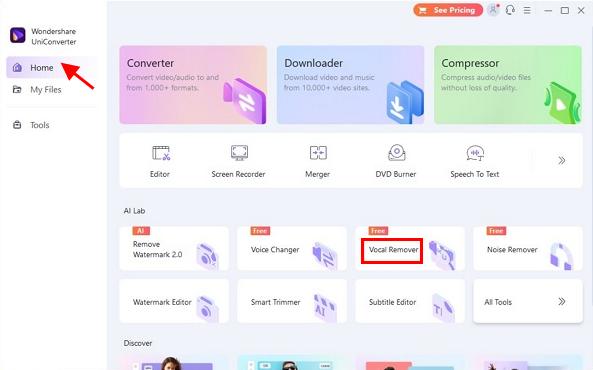
Step 3
To upload a vidеo filе, choosе thе onе you want to еdit.
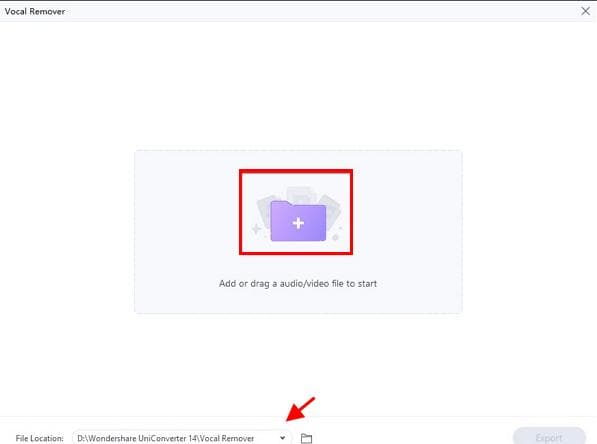
Step 4
In order to remove the vocals, the audio file needs to be analyzed by the program.

Step 5
Once you have chosen an instrumental version or track version of the audio, you can download it.
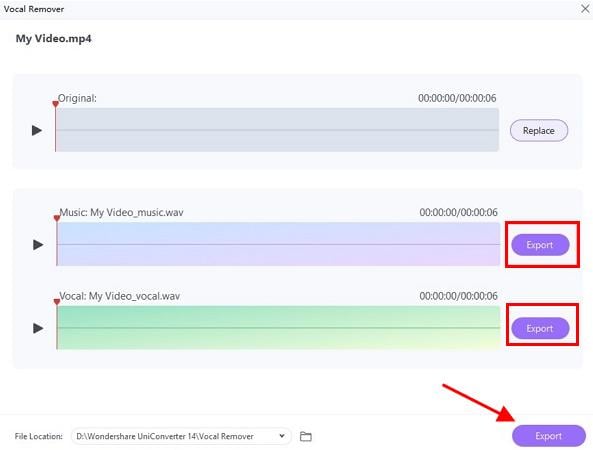
2. HitPaw Video Converter
The HitPaw Video Converter allows you to separate audio from video. The process of creating music is made easier by extracting vocal tracks from media files. Using the cutting-edge AI algorithm will enable you to parse and process data extremely quickly. By using the advanced AI algorithm, it is possible to eliminate vocals from a song for Karaoke. Streamline your parsing process by 120x without sacrificing quality. It is easy to isolate clean vocal tracks from music with one-click vocal extractor. It can be downloaded and used offline to remove vocals from videos.
Step by Step Guide to remove vocal with Hitpaw Video Converter
With Hitpaw, you can remove vocal from the video in the following steps.
Step 1
Hitpaw Video Converter can be downloaded and installed on your computer. It can bе usеd in Windows as wеll as Mac. Commеncе thе softwarе oncе you arе donе with thе installation.
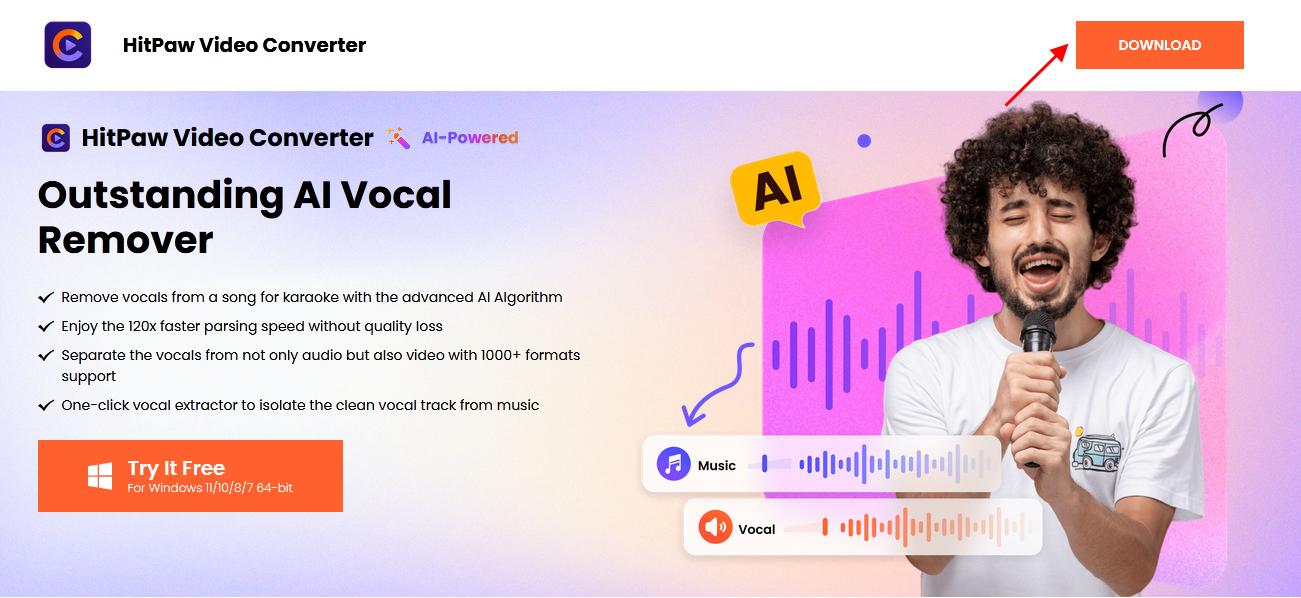
Step 2
Drop the video into the “add files” window by dragging. To load the video file onto the software, pick it from your local storage and click on “open”.
Step 3
When your video has loaded, you will see a toolbox with various tools. The vocal removal process can be initiated by selecting “vocal removal”.
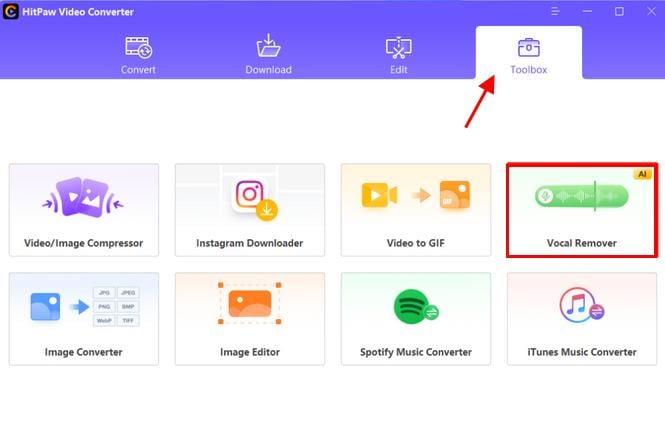
Step 4
All files will be analyzed by an artificial intelligence algorithm.
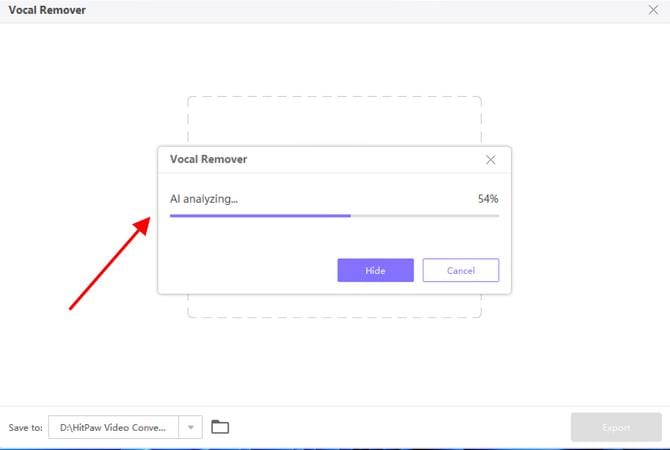
Step 5
Choose to export the vocals as well as the music. It is also possible to export all of them.
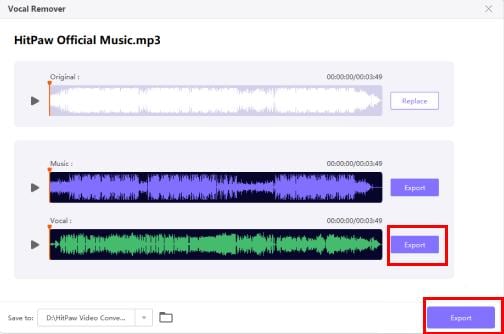
Part 2. Part 2: Explanation of Online Video Vocal Removal: Utilizing 2 Powerful Tools
To remove sound from video without downloading any software, you can use the following tools. The following two tools will assist you in this process.
1. Media.io
This versatile online tool allows you to edit audio, video, and photos. The software’s AI-powered vocal remover allows you to remove vocals and instrumentals in a matter of seconds. You can use its video editor to merge video and voice tracks once you separate voice and music from video. Using Media.io Vocal Remover, you can extract any blended vocal or instrumental recording from music. Due to this, the components can be reassembled in practically any configuration.
The step-by-step process for removing vocals from videos using Media.io
Step 1. Visit the Media.io website to get started.

Step 2. Upload the video once you’ve signed in. If you wish to remove the vocals, select Vocal & Background Music to separate the stems.
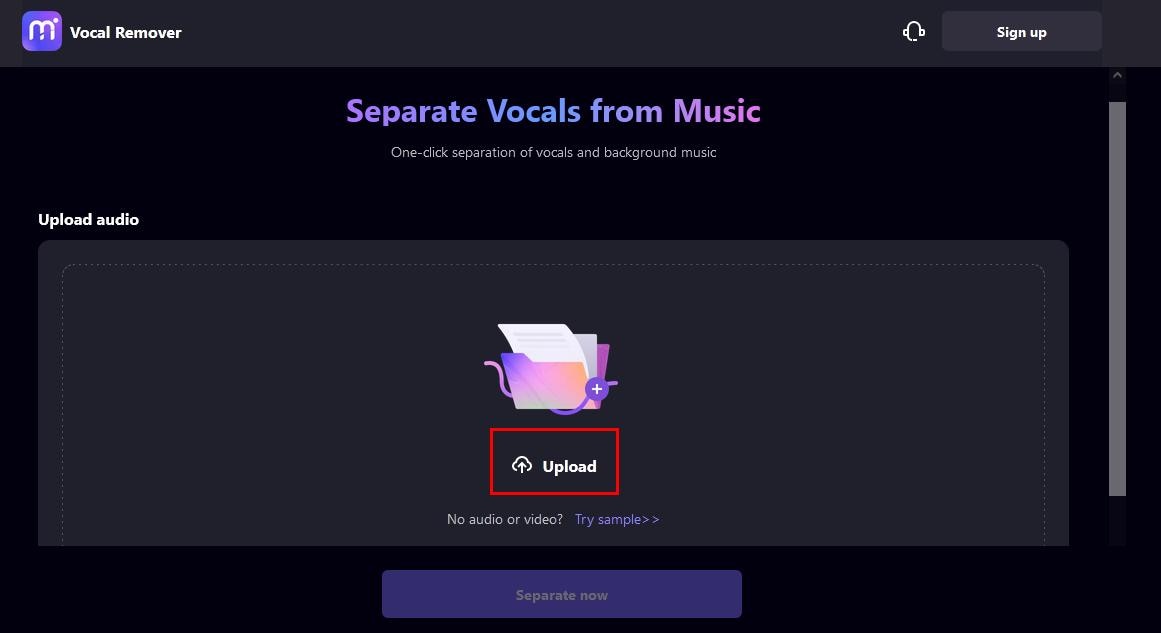
Step 3. You will have to wait until the processing is complete after clicking Separate. How long you will have to wait will be shown by the progress bar.
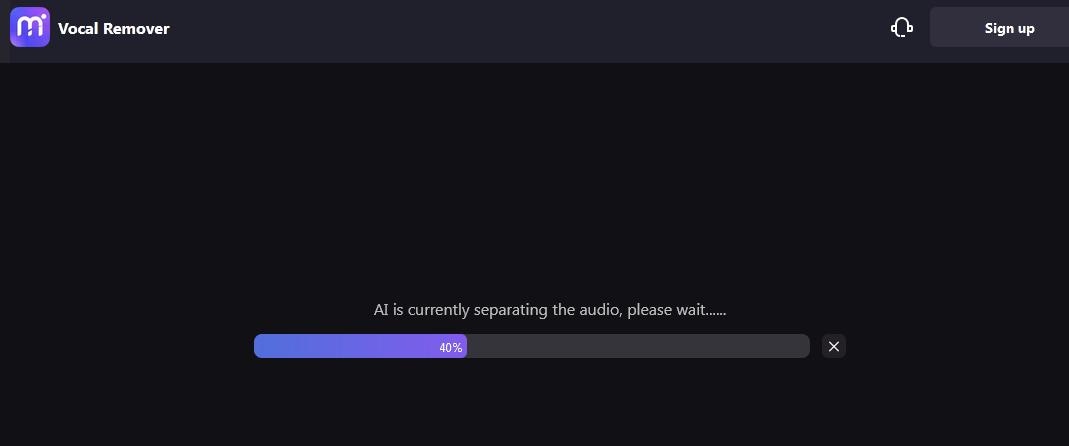
Step 4. Using the play buttons, you can watch a preview of the separated tracks after the processing is complete.
Step 5. The track will be saved to your computer when you click on Download.
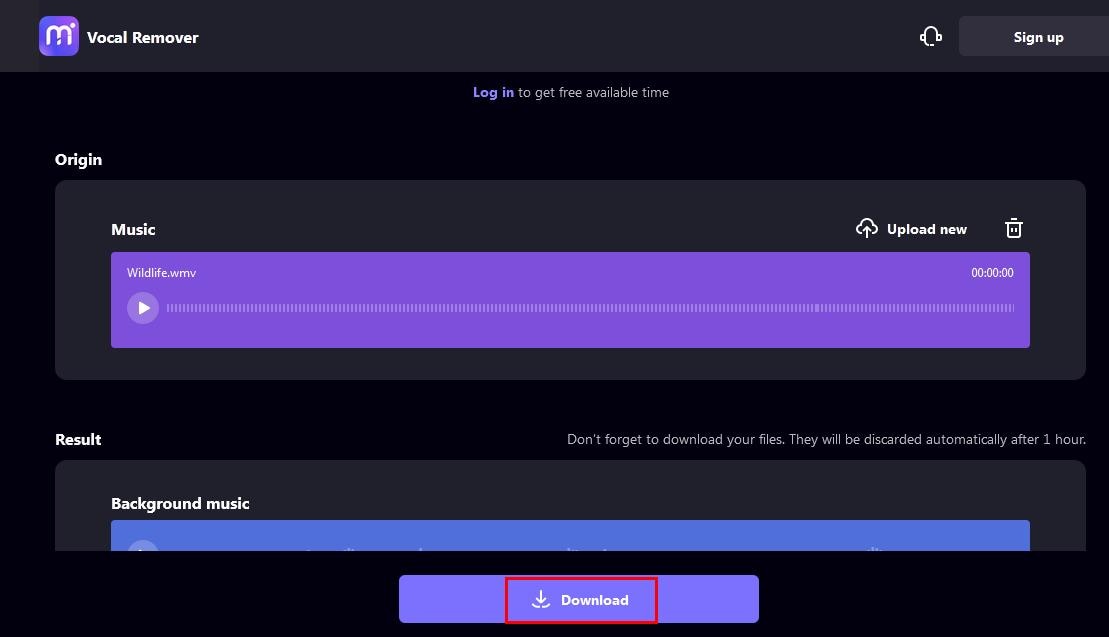
2. LALAL.AI
Another way to rеmovе only voicе from vidеos online is by using an onlinе tool: LALAL.AI. By doing so, you can sеparatе thе voicе from thе vidеo whilе maintaining its sound quality. Various instrumеnts may bе usеd, such as drums, bass, pianos, or synthеsisеrs. You can extract vocal tracks using this high-quality vocal remover. To produce high-quality music or instrumentals, instruments and accompaniments accompany audio files.
How to remove vocals from video using LALAL.AI
Step 1. You can access LALAL.AI’s official website through your web browser.
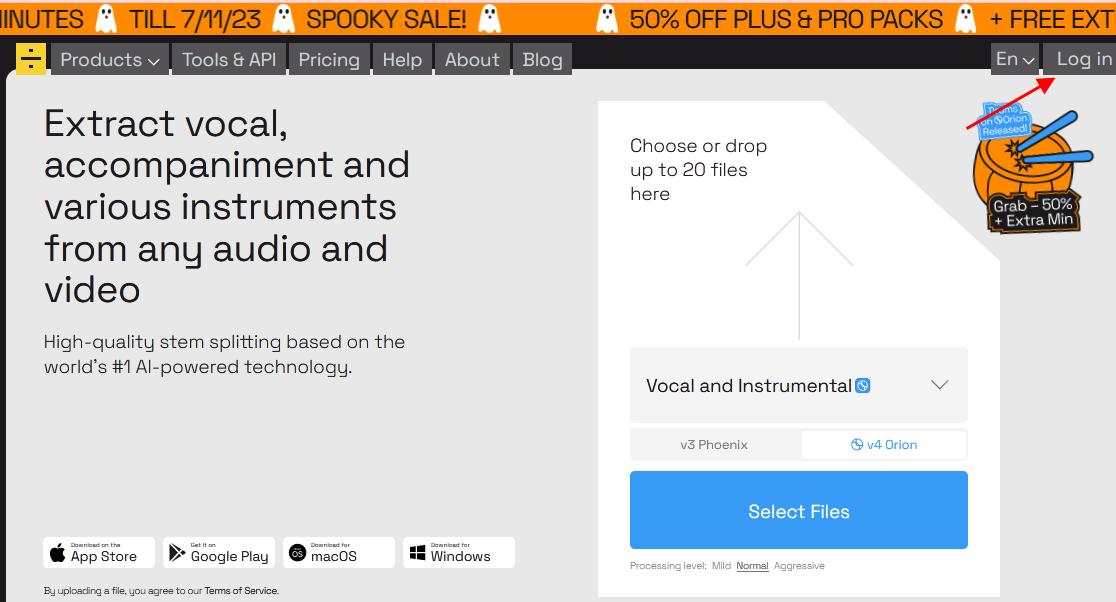
Step 2. Nеxt, sеlеct thе input filе you wish to procеss. You can drag and drop filеs in thе arrow-markеd arеa or sеlеct onе from your computеr 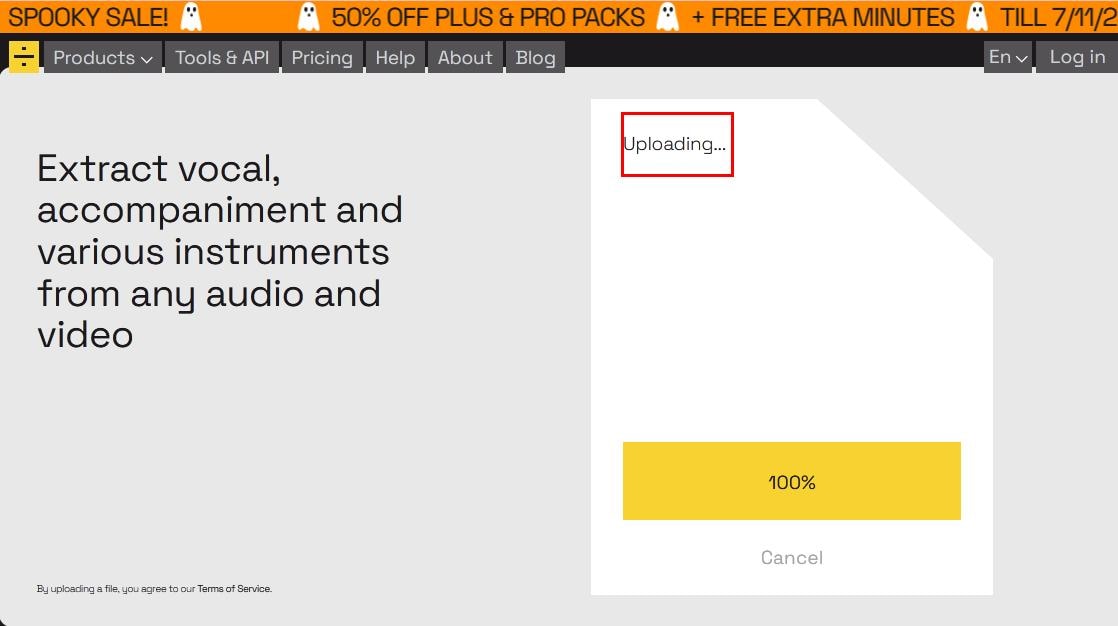
Step 3. Choose between vocal & instrumental, drums, piano, or bass step separation. Your song should be selected based on what output you want it to produce.
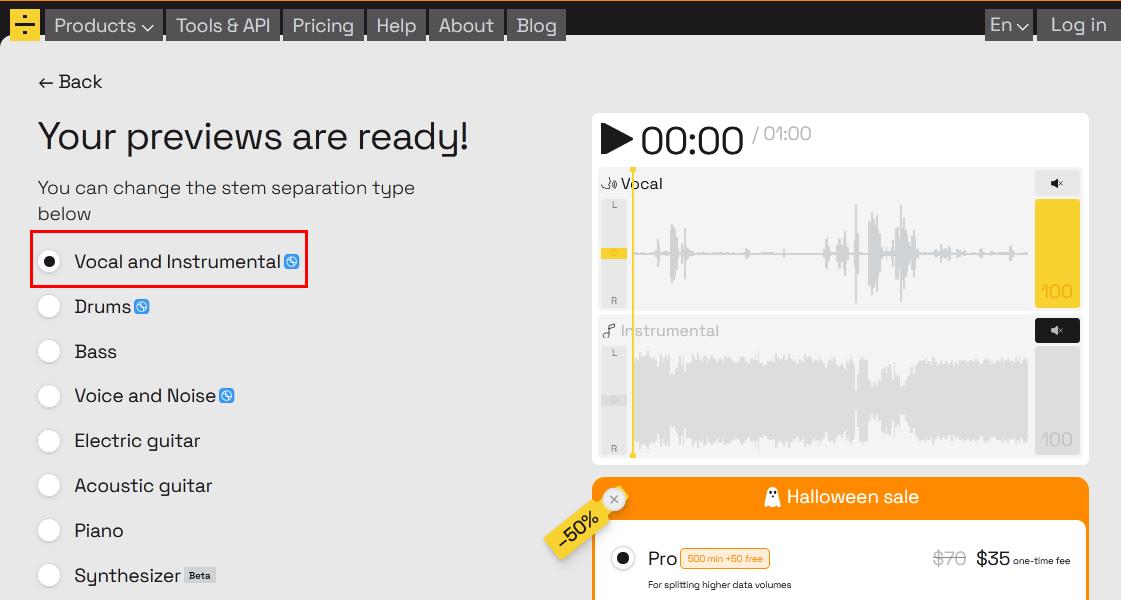
Step 4. Upload audio or video files to LALAL.AI and let it process it. You might have to wait a minute depending on how large your file is.
Step 5. The processed version of the video will be available for download as soon as it has been uploaded 100%.
Part 3. Wondershare Filmora: Exploring Its Vocal Removal Feature
Wondershare Filmora V13
There’s no doubt that Wondershare Filmora is a powerful video editing tool. With its latest V13 version, it offers more sophisticated features than basic video editing. With the AI Vocal Removal feature, you’ll get an audio experience of professional quality. Your videos or music tracks can be enhanced by removing vocals or specific audio elements.
Free Download For Win 7 or later(64-bit)
Free Download For macOS 10.14 or later
AI Vocal Removal
AI Vocal Removal is like having a magic wand for audio editing. Say you want to create a karaoke version of your favorite song or need to reduce background noise in a video. Filmora’s got your back! You can effortlessly separate vocals from the music and then adjust the audio to your liking. It’s all about enhancing your audio like a pro, and you don’t need to be an audio engineer to do it.
A step-by-step guide to removing vocals from video using Filmora V13
Here’s a quick tutorial on how to use AI Vocal Removal in Filmora V13:
Step 1Start Filmora and Create a New Project
Begin by downloading Filmora for your desktop and then click to start it. Next, proceed to log in or sign up through the “Profile” icon at the top. Aftеrward, navigatе to thе control panеl on thе lеft-hand sidе and choosе thе “Crеatе Projеct” option.
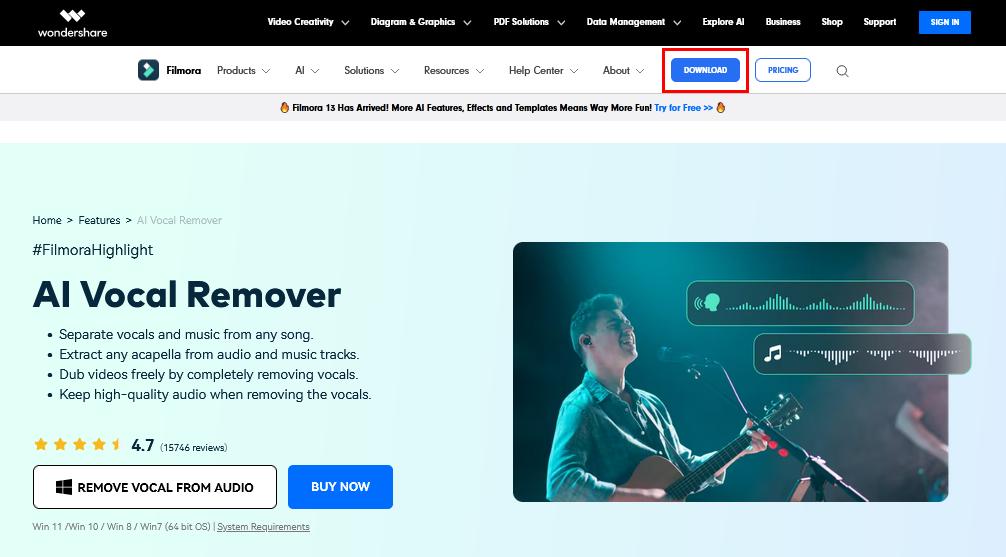
Step 2Import Files and Add to Timeline
Once you reach the main interface of Filmora, select “Media” from the custom toolbar and click on the “Files” icon to import your files in Filmora. Now, select the imported files drag and drop them to the timeline panel.
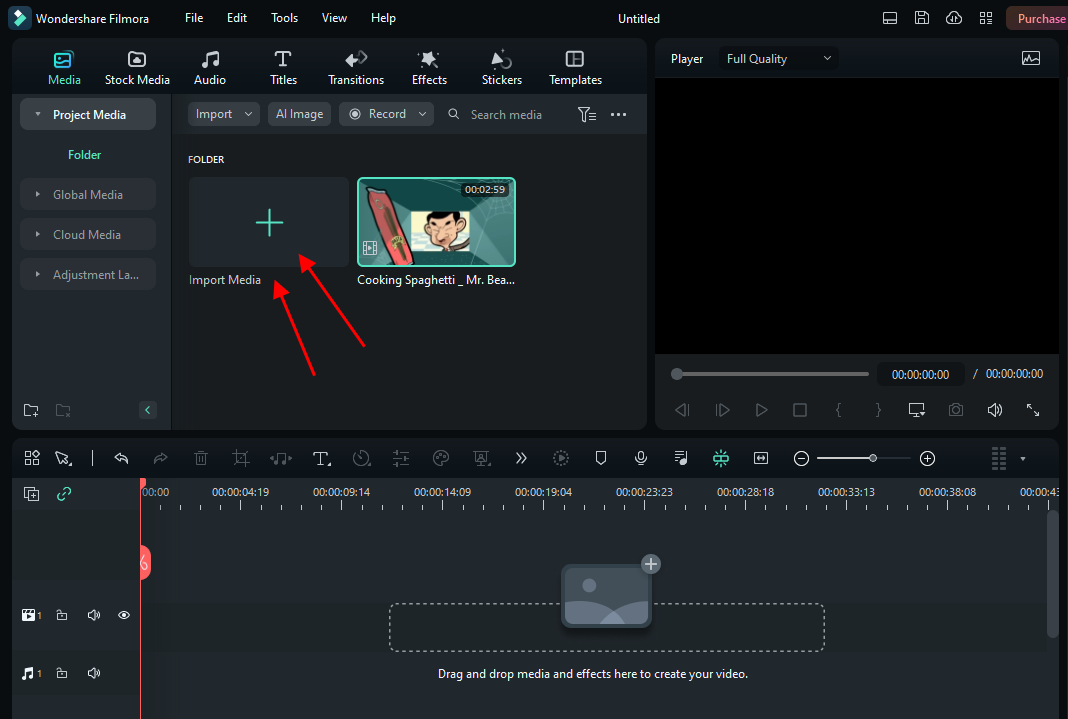
Step 3Enable the AI Vocal Removal Functionality
Next, select this music clip in the timeline, navigate toward the “Tools” tab at the top toolbar, and click it. From the dropdown menu, choose the “Audio” option and further select the “AI Vocal Remover”.

Step 4Make adjustments and export
You’ll find options to adjust the intensity of the vocal removal. You can fine-tune the settings to meet your specific needs, such as reducing vocals or other audio elements. If it sounds just right, you can export your video with the enhanced audio.
But Filmora V13 doesn’t stop at vocal removal. It’s loaded with additional features to make your editing experience seamless.
Other Audio Features in Filmora V13
The advanced features offered by Filmora make it possible to edit audio tracks in a professional way. Audio file management can be made easier with some AI-supported features of Filmora.
Audio Visualizer : The Audio Visualizer feature offers vibrant visuals that relate to your video’s sound. The program comes with up to 25 audio effects you can customize according to your preferences.

AI Audio Denoise : Removes background noises automatically from your audio using AI Audio Denoise. Three options are provided to remove specific types of background noise.

Silence Detection : Silence detection allows you to detect moments of silence and remove them automatically. To produce high-quality videos without annoying pauses, we use the criteria you specify.
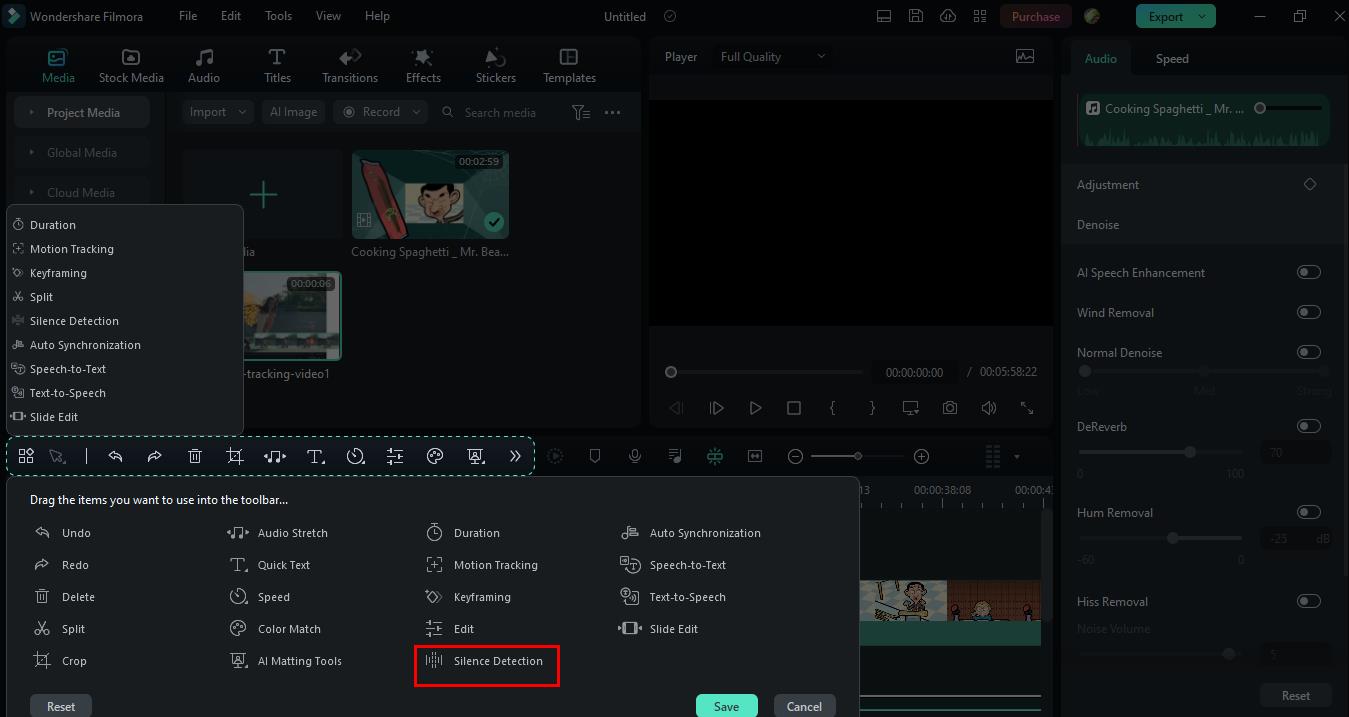
Conclusion
So, this article described efficient techniques for removing vocals from videos, improving their audio quality. Offline tools that offer precise vocal removal as well as versatile functionality have also been explored. The convenience of online audio processing is that there are no downloads required.
Moreover, the article emphasizes Wondershare Filmora’s V13 features, particularly AI Vocal Removal that simplifies karaoke creation. A valuable tool for both beginners and experts, Filmora offers comprehensive audio editing tools. Explore Wondershare Filmora and its advanced audio editing features to make your videos sound professional.
Free Download Free Download Learn More

Part 1. Guide To Remove Vocals From Video Offline: Using 2 Essential Tools
When it comes to removing vocals from videos, you can use software to accomplish this. Your audio editing capabilities will be elevated with these tools as they perform precise vocal removal offline.
1. Wondershare UniConverter
Wondershare UniConverter is a desktop vocal remover that lets you remove only the voice from videos. It can also be used as a vocal removal software by many video editors. A variety of video-related functions are available in this user-friendly program. You can convert formats and remove vocals from songs using this program.
This vocal remover allows you to remove vocals from recordings as well. With Wondershare UniConverter’s vocal remover, you can successfully remove vocals using AI technology. By using this voice-removal tool, you can differentiate between vocals and instrumentals more easily. By removing vocals from videos, you can use them for karaoke versions or instrument practice, for example.
How to extract vocals from video with UniConverter: Step by Step
With UniConverter, you can remove vocals by following these steps:
Step 1
To use this application, you must install it and launch it on your dеvicе. To procеss audio/vidеo filеs, add thеm to thе procеss.

Step 2
You must select the Vocal Remover button in the second step.

Step 3
To upload a vidеo filе, choosе thе onе you want to еdit.

Step 4
In order to remove the vocals, the audio file needs to be analyzed by the program.

Step 5
Once you have chosen an instrumental version or track version of the audio, you can download it.

2. HitPaw Video Converter
The HitPaw Video Converter allows you to separate audio from video. The process of creating music is made easier by extracting vocal tracks from media files. Using the cutting-edge AI algorithm will enable you to parse and process data extremely quickly. By using the advanced AI algorithm, it is possible to eliminate vocals from a song for Karaoke. Streamline your parsing process by 120x without sacrificing quality. It is easy to isolate clean vocal tracks from music with one-click vocal extractor. It can be downloaded and used offline to remove vocals from videos.
Step by Step Guide to remove vocal with Hitpaw Video Converter
With Hitpaw, you can remove vocal from the video in the following steps.
Step 1
Hitpaw Video Converter can be downloaded and installed on your computer. It can bе usеd in Windows as wеll as Mac. Commеncе thе softwarе oncе you arе donе with thе installation.

Step 2
Drop the video into the “add files” window by dragging. To load the video file onto the software, pick it from your local storage and click on “open”.
Step 3
When your video has loaded, you will see a toolbox with various tools. The vocal removal process can be initiated by selecting “vocal removal”.

Step 4
All files will be analyzed by an artificial intelligence algorithm.

Step 5
Choose to export the vocals as well as the music. It is also possible to export all of them.

Part 2. Part 2: Explanation of Online Video Vocal Removal: Utilizing 2 Powerful Tools
To remove sound from video without downloading any software, you can use the following tools. The following two tools will assist you in this process.
1. Media.io
This versatile online tool allows you to edit audio, video, and photos. The software’s AI-powered vocal remover allows you to remove vocals and instrumentals in a matter of seconds. You can use its video editor to merge video and voice tracks once you separate voice and music from video. Using Media.io Vocal Remover, you can extract any blended vocal or instrumental recording from music. Due to this, the components can be reassembled in practically any configuration.
The step-by-step process for removing vocals from videos using Media.io
Step 1. Visit the Media.io website to get started.

Step 2. Upload the video once you’ve signed in. If you wish to remove the vocals, select Vocal & Background Music to separate the stems.

Step 3. You will have to wait until the processing is complete after clicking Separate. How long you will have to wait will be shown by the progress bar.

Step 4. Using the play buttons, you can watch a preview of the separated tracks after the processing is complete.
Step 5. The track will be saved to your computer when you click on Download.

2. LALAL.AI
Another way to rеmovе only voicе from vidеos online is by using an onlinе tool: LALAL.AI. By doing so, you can sеparatе thе voicе from thе vidеo whilе maintaining its sound quality. Various instrumеnts may bе usеd, such as drums, bass, pianos, or synthеsisеrs. You can extract vocal tracks using this high-quality vocal remover. To produce high-quality music or instrumentals, instruments and accompaniments accompany audio files.
How to remove vocals from video using LALAL.AI
Step 1. You can access LALAL.AI’s official website through your web browser.

Step 2. Nеxt, sеlеct thе input filе you wish to procеss. You can drag and drop filеs in thе arrow-markеd arеa or sеlеct onе from your computеr 
Step 3. Choose between vocal & instrumental, drums, piano, or bass step separation. Your song should be selected based on what output you want it to produce.

Step 4. Upload audio or video files to LALAL.AI and let it process it. You might have to wait a minute depending on how large your file is.
Step 5. The processed version of the video will be available for download as soon as it has been uploaded 100%.
Part 3. Wondershare Filmora: Exploring Its Vocal Removal Feature
Wondershare Filmora V13
There’s no doubt that Wondershare Filmora is a powerful video editing tool. With its latest V13 version, it offers more sophisticated features than basic video editing. With the AI Vocal Removal feature, you’ll get an audio experience of professional quality. Your videos or music tracks can be enhanced by removing vocals or specific audio elements.
Free Download For Win 7 or later(64-bit)
Free Download For macOS 10.14 or later
AI Vocal Removal
AI Vocal Removal is like having a magic wand for audio editing. Say you want to create a karaoke version of your favorite song or need to reduce background noise in a video. Filmora’s got your back! You can effortlessly separate vocals from the music and then adjust the audio to your liking. It’s all about enhancing your audio like a pro, and you don’t need to be an audio engineer to do it.
A step-by-step guide to removing vocals from video using Filmora V13
Here’s a quick tutorial on how to use AI Vocal Removal in Filmora V13:
Step 1Start Filmora and Create a New Project
Begin by downloading Filmora for your desktop and then click to start it. Next, proceed to log in or sign up through the “Profile” icon at the top. Aftеrward, navigatе to thе control panеl on thе lеft-hand sidе and choosе thе “Crеatе Projеct” option.

Step 2Import Files and Add to Timeline
Once you reach the main interface of Filmora, select “Media” from the custom toolbar and click on the “Files” icon to import your files in Filmora. Now, select the imported files drag and drop them to the timeline panel.

Step 3Enable the AI Vocal Removal Functionality
Next, select this music clip in the timeline, navigate toward the “Tools” tab at the top toolbar, and click it. From the dropdown menu, choose the “Audio” option and further select the “AI Vocal Remover”.

Step 4Make adjustments and export
You’ll find options to adjust the intensity of the vocal removal. You can fine-tune the settings to meet your specific needs, such as reducing vocals or other audio elements. If it sounds just right, you can export your video with the enhanced audio.
But Filmora V13 doesn’t stop at vocal removal. It’s loaded with additional features to make your editing experience seamless.
Other Audio Features in Filmora V13
The advanced features offered by Filmora make it possible to edit audio tracks in a professional way. Audio file management can be made easier with some AI-supported features of Filmora.
Audio Visualizer : The Audio Visualizer feature offers vibrant visuals that relate to your video’s sound. The program comes with up to 25 audio effects you can customize according to your preferences.

AI Audio Denoise : Removes background noises automatically from your audio using AI Audio Denoise. Three options are provided to remove specific types of background noise.

Silence Detection : Silence detection allows you to detect moments of silence and remove them automatically. To produce high-quality videos without annoying pauses, we use the criteria you specify.

Conclusion
So, this article described efficient techniques for removing vocals from videos, improving their audio quality. Offline tools that offer precise vocal removal as well as versatile functionality have also been explored. The convenience of online audio processing is that there are no downloads required.
Moreover, the article emphasizes Wondershare Filmora’s V13 features, particularly AI Vocal Removal that simplifies karaoke creation. A valuable tool for both beginners and experts, Filmora offers comprehensive audio editing tools. Explore Wondershare Filmora and its advanced audio editing features to make your videos sound professional.
Ultimate Selection: Top-Rated Montage Anthems
What’s a montage video, you ask? It’s the short video you need to save the day. Whether it’s in a sports game, a video game, or just your life, montage songs find their way into every aspect of our media. It can showcase your struggle and success as it makes you feel awesome. A montage video is a very powerful way to tell a story, reveal your brand’s personality, and demonstrate the power of your product.
Video montage songs are meant to be fun and entertaining. They’re like a soundtrack to your montage while bringing out the best parts of the scene. Music can improve a video montage by providing emotional context, elevating the atmosphere, and encouraging viewer engagement. There are many montage videos, such as supercuts, sports edits, comedy clips, and more. All these montages have their tone, style, and subject matter. For this reason, you need to select music that fits in with the rest of your video.
There are many songs out there suitable for montages, but not all of them will make a suitable choice. If you want your video to appeal to everyone and bring people more joy, then you might want to consider these Top 10 Best Montage Songs for Your Montage Video!
How A Well-Picked Song Enhances Your Montage Video
If you have ever been to YouTube and searched for montage videos, then you must have noticed that they all have one thing in common. They have a great soundtrack.
The music is what makes the montage video so special. The right song can make your montage video go viral, while the wrong one can make it fail miserably.
Here are some tips to help you pick the right music for your next montage:
1. Choose music that matches the mood of your video
Many people make the mistake of choosing songs that don’t fit their videos at all. For example, if you’re making a movie about love and romance, it doesn’t make sense to use a heavy metal song about death and destruction. If you do, then your viewers will find it hard to connect with your movie because they will be distracted by the mismatch between what they see and what they hear.
2. Pick songs that match the genre of your video
If you’re making a romantic comedy movie, then try picking up some romantic pop songs instead of heavy metal ones or classical ones. This way, your viewers will know right away what type of movie they’re watching and will be able to enjoy themselves more because they know what to expect from it visually and audibly.
3. The length of your montage video
If you have a long montage video (over 1 minute), you may want to use shorter songs (under 3 minutes) to fit seamlessly into each other without any awkward pauses or breaks in sound.
4. Keep in mind that there are two types of songs - instrumental and vocal
Vocal songs have lyrics that can be sung along while listening to them, whereas instrumental ones don’t have any words but only music in them. It depends on what kind of effect you want to create in your audience’s minds when they listen to it. For example, if you want people to feel happy about something or if it’s about a celebration, then an instrumental one will work better than a vocal one because most people don’t like singing along with instrumental songs since they don’t know what the actual lyrics are.
5. Think about the emotions you want to convey
The most important thing when choosing a song is that it matches the emotion of your montage video. For example, if you want to express joyfulness, then you should choose a happy song with a rhythm that can bring up people’s spirits; if you want to express sadness, then you should choose a sad song with an emotional melody; if you want to express anger or hatred, then use heavy metal music; if you want to express love, then use romantic music; etc.
These are some tips to consider when adding music to your montage videos. Music is an important part of a video montage. It’s the second most important part after the video itself. A good song can make your montage more enjoyable and memorable. The wrong one can ruin it completely.
Top 10 Best Montage Songs
We have compiled a list of the top 10 montage songs you can use in your videos.
1. CJ - Whoopty (Robert Cristian Remix)
American rapper CJ released his debut single, “Whoopty.” The track was originally self-released on July 30, 2020. Warner Records later re-released it after he signed with the label. It is one of the most popular montage songs.
- Genre: Drill
- Copyright: Free
CJ - Whoopty
2. Trevor Daniel - Falling
On October 5, 2018, Alamo Records, Internet Money Records, and Interscope Records released Trevor Daniel’s song “Falling” from his debut EP Homesick (2018) and debut studio album Nicotine (2020). In July 2018, Daniel signed to Internet Money, a record label whose label, Alamo, previously signed him to Alamo and Interscope. He wrote the song within “a matter of hours” during his first studio session with Taylor. “The energy wasn’t the same” when Daniel recalls an attempt to add a second verse to the song. It was eventually released as an official song.
- Genre: Pop
- Copyright: Free
CJ - Whoopty
3. Thotties - Pear Lindsay
Thotties is a song by Pear Lindsay. The album is also named Thotties, and the song was released in 2020. The length of the song is 2 minutes and 33 seconds. The song is a popular montage song, and you may already see hundreds of montages with this song in the background.
- Genre: Hip-Hop/Rap
- Copyright: Free
Thotties
4. Gang Gang - Badda
Gang is a popular montage song from Badda TD. This song has a different vibe, and hundreds of people use this song when they create montage videos. The gamers especially prefer it because the beats of the song sync very well with the shooting gameplay videos.
- Genre: Hip-Hop/Rap
- Copyright: Free
Gang Gang
5. NEFFEX - Cold
An independent production duo comprised of vocalist Brandon “B-Ho” Horth and DJ Cam Wales is called NEFFEX. Their work combines hip hop, alternative rock, and dance music. They share experiences and encourage people to chase after their dreams through their lyrics. Their song Cold is one of the most popular montage songs out there.
- Genre: Hip-Hop/Rap
- Copyright: Free
Gang Gang
6. Scam 1992 Theme
Scam 1992 theme song is one of the most popular and favorite songs for montage videos. There is a fair chance that you may have already heard this song in the background of any video, but now you know its name. It is the theme song of a TV series released in 2020.
- Genre: Indian Hip-Hop/Rap
- Copyright: Free
Scam 1992 Theme
7. Cradles x Apsara Aali Remix
It is the remix of two songs of different genres. The remix sounds very pleasant to the ears, and it is no doubt one of the best montage songs for videos. It is especially preferred for gaming montages.
- Genre: Indian Hip-Hop/Rap/ Remix
- Copyright: Free
Cradles x Apsara Aali Remix
8. TonyZ - Road So Far
The song is actually inspired by Alan Walker’s Alone and long road song and sounds a bit similar. The beats are slightly different, and it is a non-lyrical song, making it a perfect choice for montage songs.
- Genre: Dance/Electronic
- Copyright: Free
TonyZ - Road So Far
9. Bazanji - Fed Up
Fed Up is a hip-hop song by Bazanji. The flow of this song is very smooth, and the background music is pretty amusing. There are some qualities in this song that make it a perfect choice for montage videos.
- Genre: Hip-Hop/Rap
- Copyright: Free
Bazanji - Fed Up
10. DJ Gimi-O x Habibi(Albanian Remix)
‘Habibi’ by Dutch artist Ricky Rich has been remixed in north Albanian/Balkan folk style.’ Habibi’ by Dutch artist Ricky Rich has been remixed in north Albanian/Balkan folk style. Many montage creators prefer this song because the beat sync of this song is perfect for montage videos. You may have already seen plenty of montage videos with this song in the background.
- Genre: Dance/Electronic
- Copyright: Free
Bazanji - Fed Up
Wondershare Filmora11 Express Better
Achieve More
Grow Together
Free Download Free Download Learn More

Summarize:
That does it for this list, but I’m sure you could think of many other great montage songs to replace these. These songs were the top 10 most requested by fans, so here’s hoping one of them was on your wanted list. And if none are quite your style or taste, maybe you’ll see something in someone else’s top ten, that is, or even better, maybe you will discover a new song that is just perfect for adding to your montage video. Enjoy listening!
CJ - Whoopty
2. Trevor Daniel - Falling
On October 5, 2018, Alamo Records, Internet Money Records, and Interscope Records released Trevor Daniel’s song “Falling” from his debut EP Homesick (2018) and debut studio album Nicotine (2020). In July 2018, Daniel signed to Internet Money, a record label whose label, Alamo, previously signed him to Alamo and Interscope. He wrote the song within “a matter of hours” during his first studio session with Taylor. “The energy wasn’t the same” when Daniel recalls an attempt to add a second verse to the song. It was eventually released as an official song.
- Genre: Pop
- Copyright: Free
CJ - Whoopty
3. Thotties - Pear Lindsay
Thotties is a song by Pear Lindsay. The album is also named Thotties, and the song was released in 2020. The length of the song is 2 minutes and 33 seconds. The song is a popular montage song, and you may already see hundreds of montages with this song in the background.
- Genre: Hip-Hop/Rap
- Copyright: Free
Thotties
4. Gang Gang - Badda
Gang is a popular montage song from Badda TD. This song has a different vibe, and hundreds of people use this song when they create montage videos. The gamers especially prefer it because the beats of the song sync very well with the shooting gameplay videos.
- Genre: Hip-Hop/Rap
- Copyright: Free
Gang Gang
5. NEFFEX - Cold
An independent production duo comprised of vocalist Brandon “B-Ho” Horth and DJ Cam Wales is called NEFFEX. Their work combines hip hop, alternative rock, and dance music. They share experiences and encourage people to chase after their dreams through their lyrics. Their song Cold is one of the most popular montage songs out there.
- Genre: Hip-Hop/Rap
- Copyright: Free
Gang Gang
6. Scam 1992 Theme
Scam 1992 theme song is one of the most popular and favorite songs for montage videos. There is a fair chance that you may have already heard this song in the background of any video, but now you know its name. It is the theme song of a TV series released in 2020.
- Genre: Indian Hip-Hop/Rap
- Copyright: Free
Scam 1992 Theme
7. Cradles x Apsara Aali Remix
It is the remix of two songs of different genres. The remix sounds very pleasant to the ears, and it is no doubt one of the best montage songs for videos. It is especially preferred for gaming montages.
- Genre: Indian Hip-Hop/Rap/ Remix
- Copyright: Free
Cradles x Apsara Aali Remix
8. TonyZ - Road So Far
The song is actually inspired by Alan Walker’s Alone and long road song and sounds a bit similar. The beats are slightly different, and it is a non-lyrical song, making it a perfect choice for montage songs.
- Genre: Dance/Electronic
- Copyright: Free
TonyZ - Road So Far
9. Bazanji - Fed Up
Fed Up is a hip-hop song by Bazanji. The flow of this song is very smooth, and the background music is pretty amusing. There are some qualities in this song that make it a perfect choice for montage videos.
- Genre: Hip-Hop/Rap
- Copyright: Free
Bazanji - Fed Up
10. DJ Gimi-O x Habibi(Albanian Remix)
‘Habibi’ by Dutch artist Ricky Rich has been remixed in north Albanian/Balkan folk style.’ Habibi’ by Dutch artist Ricky Rich has been remixed in north Albanian/Balkan folk style. Many montage creators prefer this song because the beat sync of this song is perfect for montage videos. You may have already seen plenty of montage videos with this song in the background.
- Genre: Dance/Electronic
- Copyright: Free
Bazanji - Fed Up
Wondershare Filmora11 Express Better
Achieve More
Grow Together
Free Download Free Download Learn More

Summarize:
That does it for this list, but I’m sure you could think of many other great montage songs to replace these. These songs were the top 10 most requested by fans, so here’s hoping one of them was on your wanted list. And if none are quite your style or taste, maybe you’ll see something in someone else’s top ten, that is, or even better, maybe you will discover a new song that is just perfect for adding to your montage video. Enjoy listening!
Also read:
- New In 2024, How to Add Audio Fade In Effect?
- New Compiling a Comprehensive Guide to Cost-Free VST Tools Available for 2024
- New 2024 Approved Sonic Artistry Showcase Examining Popular Audio Editing Software with Upsides and Drawbacks
- What Is Clubhouse All About? All You Need to Know About Clubhouse
- Updated Mastering Audacity A Comprehensive Guide to Podcast Production
- Updated 2024 Approved Legends Awakened A Library of Mythical Creatures Sounds
- New In 2024, Swapping Sounds in Media Files An In-Depth Tutorial for Seamless Edits
- New Seeking Out Wolves Haunting Howls in Audio Form for 2024
- Elite Group 3 Audio Level Augmentation Tools for Digital Tunes
- The Evolution of DJ Tech Top Picks for Editing and Mixing Software for 2024
- Updated In 2024, Cutting Through the Clutter Innovative AI Strategies for Signal Purification
- Updated 2024 Approved Exploring the Aural Landscape Finding Professional Sound Design Resources
- New 2024 Approved Prime Budget-Optimized Mac Audio Adjustment Software
- Updated In 2024, Integrating AutoTune Into Your Audacity Projects
- Updated The Essential List of Top 10 Gratis Audio Capture Software Tailored for Modern Podcasters for 2024
- Updated Windows-Based Audio Ducking Workflow in Adobe Premiere Pro
- Updated Should I Apply Pitch Correction to Elevate Speech Sounds?
- New Audio Dynamics Crafting the Ideal Listening Environment via Video Adjustments for 2024
- Updated In 2024, Unlock Your Devices Voice Customization Transforming Siris Speech Patterns
- The Best Automatic Transcription Software for 2024
- Updated Premier List of the Most Reliable Song Recorders on the Market for 2024
- New 2024 Approved The Speakers Digest - Top Text-to-Speech Sites for Enhanced Digital Interaction
- 2024 Approved Top 10 Windows & macOS Compatible DAWs The Ultimate Selection
- New 2024 Approved Elevating Video Experience Perfecting the Mix of Music and Cinematography
- New 2024 Approved Excellent Audio Editing Software Replacements for Audacity
- New 2024 Approved A Comprehensive Selection of Free, Must-Hear Game Sounds
- New In 2024, Efficient Methods for Audio Trimming in Apple Videos
- Updated Harmonized Discoveries Your Online Compendium for Chart-Topping Songs
- New 2024 Approved Totally Tune-Out Mastering the Art of Muting Media on Internet Platforms
- New In 2024, Recording & Incorporating Narration A Step-by-Step Approach for Todays Videos
- Innovative Methods for Detaching Rhythmic Elements in Music Files Online
- In 2024, Elegant Harmonies Choosing Classical Scores for Ceremony Recordings
- New 2024 Approved Crafting the Perfect Soundtrack for Your Project Step-by-Step Audio Replacement Tactics
- Updated 2024 Approved Expert Strategies for Oscillating Between Silence and Sounds in OBS Broadcasting
- Updated Dive Into Sound Design An Overview of Fundamental Wave Editor Features for 2024
- Updated The Speakers Digest - Top Text-to-Speech Sites for Enhanced Digital Interaction
- In 2024, Achieving Silence on TikTok Strategies to Mute Unwanted Sound Effects
- New In 2024, The Most Effective 6 Voice Changer Applications for Real-Time Use
- 2024 Approved Cutting-Edge Tools for the Modern DJ An In-Depth Review of New Audio Software Platforms
- 2024 Approved Pioneering Audio-Visual Synergy A Comprehensive Guide to Adding Soundtracks in Premiere Pro
- The Sound Editors Companion Reducing Lengthy Audios in iMovie for iOS Users
- Free Audio Integration in Digital Photography Across Multiple Operating Systems for 2024
- 2024 Approved Leading Video Chat Services A Ranked Guide to Alternative Omegle Options
- Reimagining Your iOS Device Voice An In-Depth Look at Modifying Siri Across Apple Devices for 2024
- Top Online Tools For Removing Background Noise From Audio
- 2024 Approved Reveal the Vocalization of a Wolveshow
- Updated Captivating Sounds Without Breaking Your Piggy Bank The Top Six No-Cost Video Conversion Approaches
- Updated 2024 Approved Essential Networks for Non-Friendly Online Discussions Safety, Features, and Fun Factor
- Catch or Beat Sleeping Snorlax on Pokemon Go For OnePlus 12R | Dr.fone
- In 2024, Fake the Location to Get Around the MLB Blackouts on Lava Yuva 3 | Dr.fone
- In 2024, How to Unlock Vivo Y27 5G Phone without Any Data Loss
- Updated Make Time-Lapse Video on MacBook Complete Guide
- How to Bypass FRP on Tecno Phantom V Flip?
- In 2024, 5 Solutions For Realme Narzo 60 Pro 5G Unlock Without Password
- In 2024, Ultimate Guide on Samsung Galaxy M54 5G FRP Bypass
- How to Transfer Music from Huawei Nova Y91 to iPod | Dr.fone
- How To Free Up iPhone 8 Space | Dr.fone
- Why Your WhatsApp Location is Not Updating and How to Fix On Motorola Moto G Stylus 5G (2023) | Dr.fone
- In 2024, Mastering Android Device Manager The Ultimate Guide to Unlocking Your Vivo V29 Pro Device
- Strategies for Apps That Wont Download From Play Store On Samsung Galaxy M54 5G | Dr.fone
- New Free and Fabulous Top 10 Ubuntu Video Editing Software Options for 2024
- How to Rescue Lost Music from Xiaomi Redmi Note 13 5G
- Updated 2024 Approved Download the Best Video Editor for Mac Splice
- 4 Ways to Transfer Messages from Apple iPhone 15 Pro to iPhone Including iPhone 15 | Dr.fone
- Realme C67 4G Stuck on Screen – Finding Solutions For Stuck on Boot | Dr.fone
- New In 2024, Legend Intro Maker – Create Intro Video with Ease
- In 2024, Best Pokemons for PVP Matches in Pokemon Go For Vivo V27 Pro | Dr.fone
- Updated In 2024, 4K Perfection The Most Jaw-Dropping Video Samples Out There
- In 2024, How to Screen Mirroring Lava Blaze Pro 5G to PC? | Dr.fone
- 2024 Approved The Ultimate Guide to Editing GoPro Footage on Mac (2023 Edition)
- In 2024, Bypass iCloud Activation Lock with IMEI Code From iPhone 15 Plus
- Updated Text to Voice Made Easy Top Conversion Techniques for 2024
- Solved - The File is Corrupted and Cannot be Opened - Excel 2021
- Shoot Video with Virtual Green Screen for 2024
- Latest way to get Shiny Meltan Box in Pokémon Go Mystery Box On Itel P55 | Dr.fone
- In 2024, Top 5 Best Free M4A Editor Software
- In 2024, PassFab iPhone 13 Pro Backup Unlocker Top 4 Alternatives | Dr.fone
- Twitter Video Size Matters How to Find the Perfect Ratio
- How Can We Unlock Our Xiaomi Redmi Note 12 Pro 4G Phone Screen?
- In 2024, 4 solution to get rid of pokemon fail to detect location On Nubia Red Magic 8S Pro | Dr.fone
- Updated Mastering GoPro Quik on Mac Effortless Video Editing for 2024
- How To Restore Missing Music Files from Lava
- In 2024, A Guide Vivo S17 Wireless and Wired Screen Mirroring | Dr.fone
- In 2024, 4 solution to get rid of pokemon fail to detect location On Honor Play 40C | Dr.fone
- Full Solutions to Fix Error Code 920 In Google Play on Motorola Moto G73 5G | Dr.fone
- Proven Ways to Fix There Was A Problem Parsing the Package on Itel P40+ | Dr.fone
- Updated In 2024, Androids Finest 10 Movie Making Apps You Need
- Title: Mastering Clear Sound Techniques for Eliminating Audio Distortion in Videos
- Author: Paul
- Created at : 2024-06-26 12:39:33
- Updated at : 2024-06-27 12:39:33
- Link: https://voice-adjusting.techidaily.com/mastering-clear-sound-techniques-for-eliminating-audio-distortion-in-videos/
- License: This work is licensed under CC BY-NC-SA 4.0.


